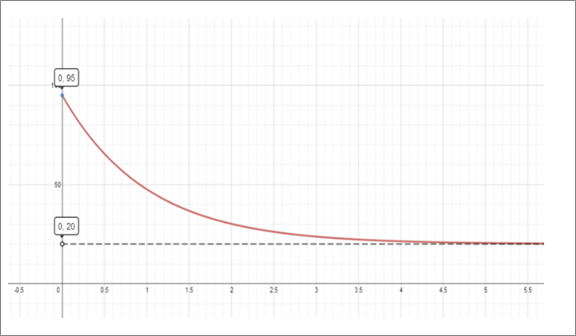
Concept explainers
a.
To find: when the coffee cools most quickly and what happens to the rate of cooling as time goes by, explain.
a.
Answer to Problem 14E
The coffee cools the quickest in the beginning, when the temperature difference
Explanation of Solution
Given information: Suppose you have just poured a cup of freshly brewed coffee with
temperature
Formula used:
Newton’s Law of Colling states that the rate of cooling of an object is proportional to the
temperature difference and its surrounding provided that this difference is not too largeNewton’s Law of Cooling:
Calculation:
Since k and
The coffee cools the quickest in the beginning, when the temperature difference
b.
To write : a differential equation that expresses Newton’s Law of Colling for this particular situation and what is the initial condition and find this differential equation is an appropriate model for cooling.
b.
Answer to Problem 14E
Initial condition is
The rate of cooling is increases as T increases.
The temperature of coffee is maximum initially; hence rate of cooling is maximum initially.
Explanation of Solution
Given information: Newton’s Law of Colling states that the rate of cooling of an object is proportional to the temperature difference and its surrounding, provided that this difference is not too large.
Formula used:
Newton’s Law of Colling states that the rate of cooling of an object is proportional to the
temperature difference and its surrounding provided that this difference is not too largeNewton’s Law of Cooling:
Calculation:
Let the temperature of the coffee be T .
Temperature of the surroundings
So, According to Newton’s Law of Colling, the rate of cooling of coffee is:
Initial condition is
Equation of the curve is
Note the rate of cooling is increases as T increases.
The temperature of coffee is maximum initially; hence rate of cooling is maximum initially.
Also the rate of cooling decreases as T decreases, this is consistent with part (a).
c.
To make: a rough sketch of the graph of the solution of the initial- value problem in part (b).
c.
Answer to Problem 14E
Equation of the curve is
Explanation of Solution
Given information: Newton’s Law of Colling states that the rate of cooling of an object is proportional to the temperature difference and its surrounding, provided that this difference is not too large.
Calculation:
The graph is shown below.
Temperature is plotted on the vertical axis and time on the horizontal axis.
Note that the initial temperature is 95
As the time passes the temperature decreases but the rate of decrease slows down and the temperature of the coffee approaches 20
Equation of the curve is
Where k is a positive constant

Chapter 7 Solutions
Single Variable Calculus: Concepts and Contexts, Enhanced Edition
 Calculus: Early TranscendentalsCalculusISBN:9781285741550Author:James StewartPublisher:Cengage Learning
Calculus: Early TranscendentalsCalculusISBN:9781285741550Author:James StewartPublisher:Cengage Learning Thomas' Calculus (14th Edition)CalculusISBN:9780134438986Author:Joel R. Hass, Christopher E. Heil, Maurice D. WeirPublisher:PEARSON
Thomas' Calculus (14th Edition)CalculusISBN:9780134438986Author:Joel R. Hass, Christopher E. Heil, Maurice D. WeirPublisher:PEARSON Calculus: Early Transcendentals (3rd Edition)CalculusISBN:9780134763644Author:William L. Briggs, Lyle Cochran, Bernard Gillett, Eric SchulzPublisher:PEARSON
Calculus: Early Transcendentals (3rd Edition)CalculusISBN:9780134763644Author:William L. Briggs, Lyle Cochran, Bernard Gillett, Eric SchulzPublisher:PEARSON Calculus: Early TranscendentalsCalculusISBN:9781319050740Author:Jon Rogawski, Colin Adams, Robert FranzosaPublisher:W. H. Freeman
Calculus: Early TranscendentalsCalculusISBN:9781319050740Author:Jon Rogawski, Colin Adams, Robert FranzosaPublisher:W. H. Freeman
 Calculus: Early Transcendental FunctionsCalculusISBN:9781337552516Author:Ron Larson, Bruce H. EdwardsPublisher:Cengage Learning
Calculus: Early Transcendental FunctionsCalculusISBN:9781337552516Author:Ron Larson, Bruce H. EdwardsPublisher:Cengage Learning





